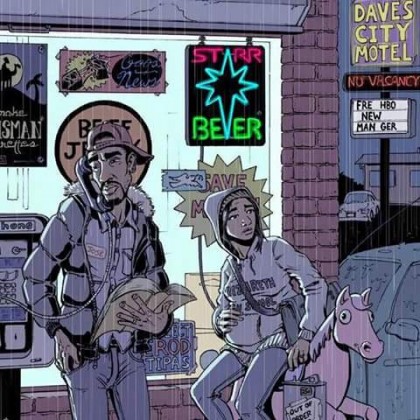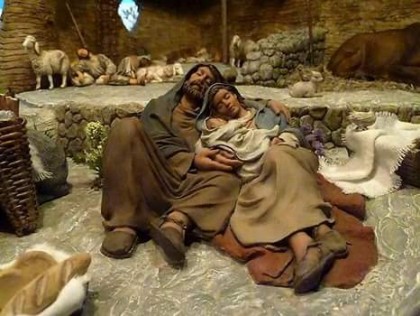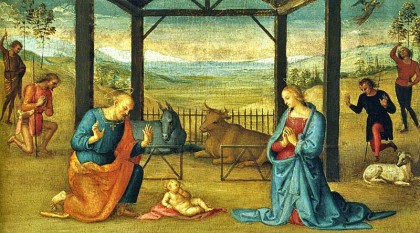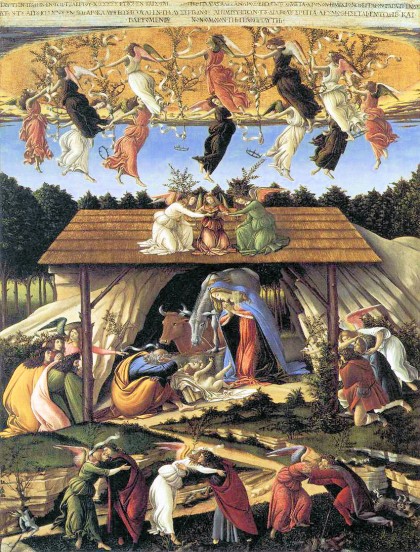Irreverant Images?
Devra Torres | Jan 1, 2016
Since it's still Christmas, here's one of my favorite Nativity images of the year:
 It's by Everett Patterson (please see the whole image and his own explanation here).
It's by Everett Patterson (please see the whole image and his own explanation here).
And here's another:

They're both strikingly non-traditional--not something I usually look for in Christmas scenes--but they capture something that many of the conventional ones don't. And that's a good thing, because when it comes to Christmas, over-familiarity is an ever-present threat. These two images wake us up with their answers to the fascinating question: What must it have been like?
The first one incorporates all kinds of clues and symbols, though at first it looks like a simple transplantation of Mary and Joseph into a modern-day bad neighborhood. But look: Dave's City, Nazareth, new manger--you may find more than you think.
Two possible objections to both images, though, are worth addressing. I haven't actually heard these, but I feel certain they are bothering some of my friends. I'd be interested to know if you've heard them, or if they're bothering you.
The first is the apparent lack of dignity in the way the Holy Family is portrayed. It's a little jarring to see St. Joseph as some sort of gas station attendant or mechanic. And I've never seen Mary in a hoodie and jeans before, or expected to be touched by the sight.
In the second image, Mary, Joseph and the Baby aren't transported into our time, but they're sprawled there, unceremonious, exhausted, their grubby footwear front and center. We're accustomed to seeing them look a little more like this:

garments falling in graceful folds, bursts of radiant color, elegant posture for all, even the Newborn.
The most obvious response is that if it troubles you to see these most exalted of saints looking worn out, sweaty and commonplace, stuck in a bad neighborhood and clothed in ordinary poor people's outfits, then your beef is with God himself, not with the artist or sculptor--since He's the one who arranged the Incarnation that way, in real life. The artists have only portrayed with ink and clay what He willed to happen in cold, hard fact.
The second question is this: doesn't this way of portraying the saints--especially in the drawing--reduce the Good News to a political statement? Look at that, St. Joseph's name in Spanish--isn't that just a cheap shot at anyone who opposes open borders? Showing us Our Lady in a hoodie and her husband as a blue-collar guy--doesn't that hint at reducing the Good News to a sentimental plea to forget about theological truth and focus on helping poor immigrants and laborers, like good secular social workers?
Well, it's true, it would be distasteful for anybody to enlist the Holy Family as a mere prop for pushing their preferred political policies. But I don't think that's what's going on here. I think it's more a concern for accuracy. St. Joseph was a manual laborer (they didn't have mechanics in those days, but probably carpenters were of comparable social status). They were poor: you can tell, because they brought turtle-doves as their offering at the temple, and that was the lowest-budget option the law allowed for the redemption of firstborn sons.
Another thing I like about the sculpture: it shows St. Joseph looking like a young, strong, affectionate husband, cushioning his wife and the baby from all the hardship he would have prevented if he could have, in the midst of his own exhaustion. It reminds me of a old photo of me and my husband, Max, on a transatlantic flight with two toddlers and a baby.
Am I saying we should get rid of the Carravaggios and the Murillos and the Botticellis?

Absolutely not! They tell just as true a story. Mary really is the Queen of Heaven and Earth, as well as a then-poverty-stricken teenager; Joseph really is the noble descendant of David the King, uniquely entrusted with protection and care of the Word Incarnate, as well as being a laborer and then a refugee;and the Baby is the omnipotent Word that leapt down from Heaven to save the human race, as well as being an apparently ordinary infant born under tough circumstances.
What do you think? Do you love the images? Do you hate them? I'd be interested to know.
